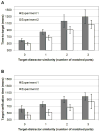Effects of part-based similarity on visual search: the Frankenbear experiment
- PMID: 22227607
- PMCID: PMC3345177
- DOI: 10.1016/j.visres.2011.12.004
Effects of part-based similarity on visual search: the Frankenbear experiment
Abstract
Do the target-distractor and distractor-distractor similarity relationships known to exist for simple stimuli extend to real-world objects, and are these effects expressed in search guidance or target verification? Parts of photorealistic distractors were replaced with target parts to create four levels of target-distractor similarity under heterogenous and homogenous conditions. We found that increasing target-distractor similarity and decreasing distractor-distractor similarity impaired search guidance and target verification, but that target-distractor similarity and heterogeneity/homogeneity interacted only in measures of guidance; distractor homogeneity lessens effects of target-distractor similarity by causing gaze to fixate the target sooner, not by speeding target detection following its fixation.
Copyright © 2011 Elsevier Ltd. All rights reserved.
Figures





References
-
- Alexander RG, Zelinsky GJ. Visual Similarity Effects in Categorical Search. Journal of Vision. 2011;11(8):9, 1–15. doi: 10.1167/11.8.9. http://www.journalofvision.org/content/11/8/9. - DOI - PMC - PubMed
-
- Ashby FG, Perrin NA. Toward a unified theory of similarity and recognition. Psychological Review. 1988;95:124–150.
-
- Becker MW, Pashler H, Lubin J. Object-Intrinsic oddities draw early saccades. Journal of Experimental Psychology: Human Perception and Performance. 2007;33:20–30. - PubMed
-
- Blanchette I, Dunbar K. How analogies are generated: The roles of structural and superficial similarity. Memory & Cognition. 2000;28(1):108–124. - PubMed
Publication types
MeSH terms
Grants and funding
LinkOut - more resources
Full Text Sources

